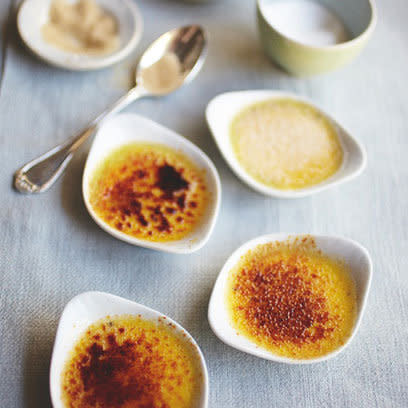Rachel Khoo’s crème brûlée

You will need
300ml double cream
200ml milk
1 vanilla pod
6 egg yolks
100g sugar for the caramel topping
30g caster sugar
30g raw cane sugar
Method
1. Pour the cream and milk into a pan. Split the vanilla pod in half lengthways and scrape out the grains. Add the pod and grains to the cream and milk. Bring to a boil, turn off the heat and remove the pod from the pan.
2. Combine the egg yolks with the sugar in a bowl, then slowly pour in the hot cream, whisking continuously. Do not overwhisk as you want to avoid creating too many bubbles.
3. If you have time, pour the custard into a bowl, cover with cling film and refrigerate overnight. This gives the vanilla grains more time to flavour the cream and milk.
4. Preheat the oven to 110ºC/Gas mark ¼. Divide the custard between six wide, shallow ramekins and place in a roasting tin. Pour cold water into the tin to come halfway up the ramekins.
5. Bake for 30 to 40 minutes or until the custard is set around the edges but still slightly wobbly in the middle. Remove the ramekins from the water and set aside until cooled to room temperature. Cover the ramekins with cling film (don’t let it touch the custard), and refrigerate for at least four hours, or overnight.
6. When ready to serve, make the caramel topping. Uncover the ramekins and check to see if condensation has collected on the custards. If it has, gently place paper towels on the surface to soak up the moisture. Mix the two types of sugar together and sprinkle a nice even layer over each custard. Do this by holding the spoon at least 30 centimetres away from the ramekin- sprinkling from a height is the best way to create an even layer of sugar.
7. Place the ramekins on a metal tray. For best results, use a hand-held blowtorch and hold it ten to twelve centimetres away from the sugar. Move the flame slowly around the sugar, maintaining a slow and even motion.
8. Stop torching just before the desired degree of caramelization is reached, as the sugar will continue to cook for a few seconds after the flame has been removed.
9. If you don’t have a blowtorch, take a large metal spoon and hold it in a gas flame until very hot (it will turn blue, almost black in colour). Place the spoon on the sugar and move it around so that the heat of the spoon caramelizes the sugar.
Recipe: The Little Paris Kitchen, Rachel Khoo (Penguin)
Click here to go to the original article on Red Online
Click here to see Rice pudding
Click here to see Best Side Dish Recipes
Click here to see Best Christmas baking recipes


